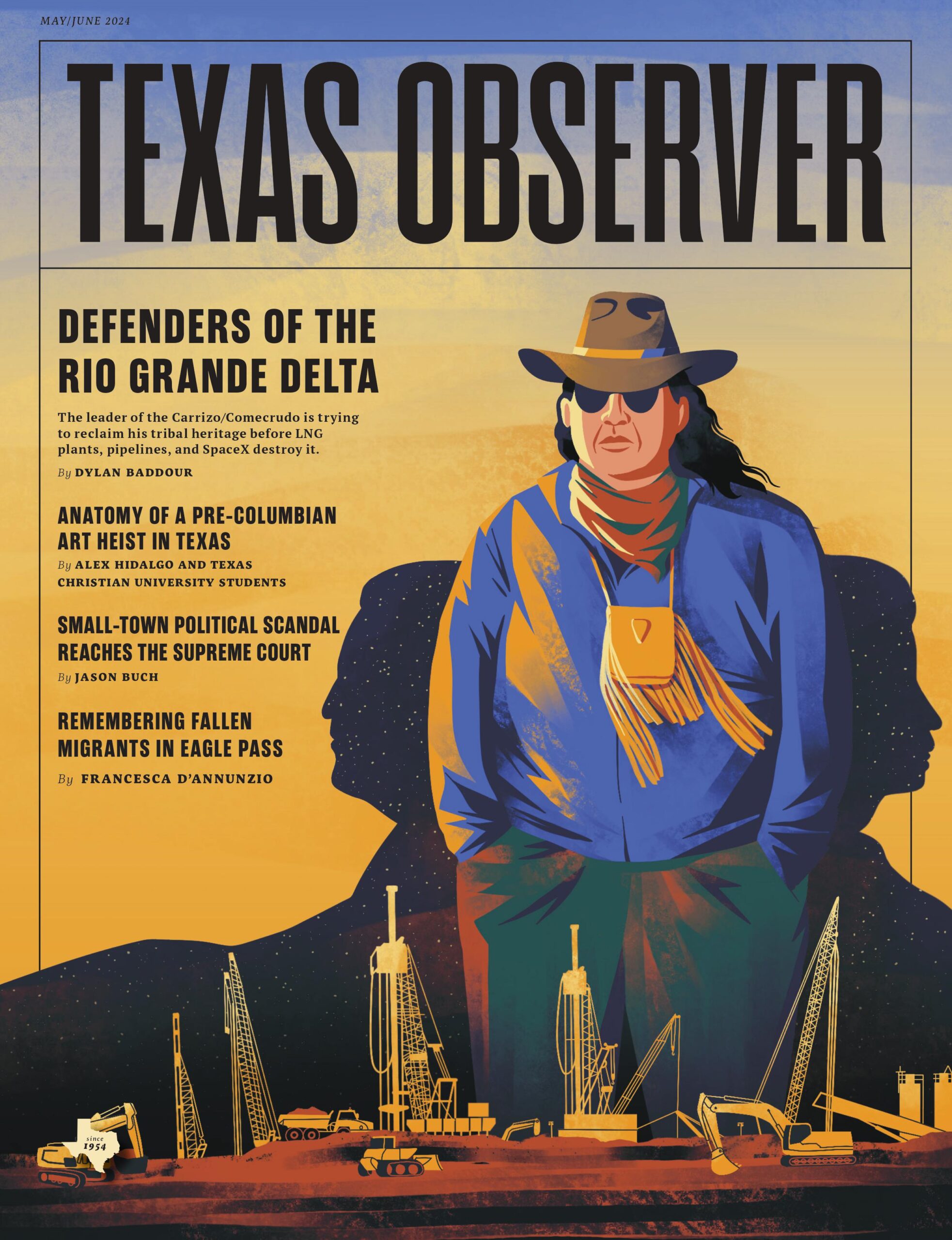ustxtxb_obs_1966_06_10_50_00006-00000_000.pdf
Page 8
Once she’d had Joe’s father over to tell him of some of his son’s misdeeds, and when she’d finished, she said, the father had said, “I thought you’d called me over here for something important.” She said, “This isn’t one of your broken homes, or the kids starving! This family was above the income limit. None of those reasons apply here.” She wished she’d put the family out a year before, since Joe had been accepted as a leader, and some other boys who might have been all right were following him now. Down the street, evidently the night or so before, another boy, she said, had at tacked a boy with a beer bottle, trying to kill him with it. As we were leaving the project a police car drove up. Inside in the front seat with the policeman there was a good looking boy, maybe 15 or 16, with dark skin and dark, perhaps frightened eyes. On the back seat lay a flat-ended machete and a shotgun, the stock taped to the barrel at three places. The patrolman said he had seen the boy with the shotgun the night before, but he had run off ; seen again this day, the boy had agreed to take the policeman to where the gun was hidden. It was under his bed where he lived, unbeknownst, his guardians said, to them. The officer said six or seven of the -boy’s friends were all down at the juvenile now. The police car pulled away from the curb, carrying the boy to juvenile, and Roy Valdez said through the window, across the policeman, to the boy, “Ask Tony to call me, will you?” The boy nodded. R.D. In Robstown Segregated and Self-Segregating Robstown From the pristine, well-ordered bungar lows of suburban Dallas I grudgingly have made my way indirectly to the wastes of South Texas and have discovered a new place. Oh, the hamlets on the region’s brushy plains have many of the familiar suburban trappings of metropolitan Texas: ranch-style brick homes with the requisite husbands barbecueing on the patio; shopping centers patronized by housewives attired in stretch pants, their hair rolled in curlers; little league baseball for the moppets; autumn’s Friday night frenzy at the football stadium. But there is morea Latin-American society, segregated and self-segregating, operating on the fringes of South Texas Anglos’ version of mid-20thcentury America, and poverty that rivals the worst in the world. Life in South Texas typically means a town where Latins are in a two-to-one or three-to-one majority, living in squalor, ruled by Anglos who wield an economic hammer. Latin families scrape by on earnings from stoop labor on farmsa declining source of income because of mechanizationand welfare. An official of the regional Office of Economic Opportunity, who worked two years with Dr. Tom Dooley in Asia, says Laredo is worse off than Hong Kong. The egalitarian spirit that pervades much of America today, thanks to the Negro, is but dimly realized in South Texas. Latins largely do not participate in the drive for wider democracy. There are stirrings, but these are so far exceptional. I am surprised to learn Texas has more Latins than Negroes. Latins are the majority in many South, Texas towns, but have few city councilmen, school board members, or mayors. This apathywhich I think is more apparent than realleads many here to feel “the Latins don’t want any more than they have now,” but Latins do yearn for a better life. An adult literacy and vocational education program for migrants in the region has drawn capacity enrollments. Demand makes it likely that federal ap The writer, news editor of the Robstown Record, is a contributing editor of the Observer. The Texas Observer Greg Olds propriations for the course will be raised by 50% in the coming fiscal year. Many in the area laid the course’s popularity to the $30 weekly stipend, but in Robstown and other cities another’ courseadult literacy for those, migrant or not, with less than an eighth grade education has proven fully as popular without a stipend. Latins are taking advantage of self-help programs under the war on poverty in a rural area near San Antonio. A similar program is in the works at Robstown’s labor camp, a cheerless agglomeration of barracks-like accommodations for workers who follow the crops for a living. Courses are proposed in home economics, citizenship, first aid, and other subjects. THOUGH T H E ROBSTOWN community has some 25,000 people, the town seems to me much smaller. In working for the weekly newspaper here I deal with the same number of news sources as I have in towns of 4,000 and 5,000all this in the dimly realized presence of a largely inarticulate, slumbering majority. Anglos have things to themselves most of the time. But Sundays downtown belong to Latin teenagers. Young girls from 12 to 16 promenade along Main Street in twos and threes. The young men participate in the folk custom by driving their battered autos, honking, whistling, and calling to the girls, a Texas adaptation of the custom in the town plazas of Mexico. \(Robstown has no ade was shattered by a gunshot, fired from one of the cruising autos into another. It’s said that a young man was avenging the lost honor of his sister, but that his shot struck the wrong passenger, who died. In all Latin families of the area who can afford it, there is a “coming out party” for each girl when she turns 16. Many presents and a new dress are given to her in sort of a female South Texas bar mitzvah. In the Latins’ social strata just below the top, girls are not supposed to date. Sometimes, when a couple want to get married, they “elope,” then return unwed, confronting their parents with the fait accompli of their cohabitation. A wedding follows in most cases, But in one case a girl moved into her boy friend’s home and did housework for a month, whereupon the prospective groom decided she wouldn’t do. The girl returned to her parents and to the jibes of her girl friends. Anglos and the few Negroes, 400 in Robstown, see reminders in common places of the proximity of another culture: 49cent jars of cut-up cactus sold in supermarkets for use in salads or as a relish; corn husks, a staple in all groceries, for making tamales at home. Local drive-ins offer tacos, tamales, tortillas, or, if you must, a sack of six hamburgers for $1. Signs in washaterias, stores, and along highways are bilingual. The cheers at high school football games sound like the Latin’s falsetto cheer, “oy, oy!” a cry familiar in such Mexican musical stand-bys as “El Rancho Grande.” Spanish is not spoken, but something called Tex-Mex, an amalgamation of Spanish slang and adapted English terms, such as “pumpa,” meaning faucet. Latin-American students can take beginning Spanish at school, a fact attesting to the difference between school Spanish and the spoken tongue. TV programming includes a two-and-ahalf hour Sunday morning variety show, “Panorama Latino,” on which the emcee alternates in mid-sentence between Spanish and English, introducing musical acts, interviewing politicos, pushing Jax Beer, and announcing future events of interest to the Spanish-speaking community. The program is followed by bullfights, taped in Mexico City, complete with the moment of truth despite the protests of cringing Anglo viewers. FOR A TIME in Robstown the only swimming pool was a private one for Anglos only. Two years ago the city built a pool, but it’s used little by Latins; the first week of its operation a Latin youth drowned and this has stigmatized the place for many parents. There is virtually complete social segregation, apparently by mutual agreement. The only school-sponsored dance during the year is the juniorsenior prom, where Negroes, Latins, and Anglos segregate themselves at tables in separate parts of the room. The same segregation prevails in school cafeterias. Anglos throughout the school year have their own social functions, usually at the country


